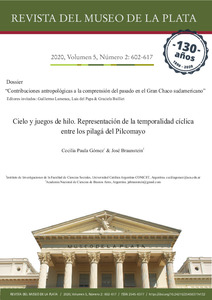Please use this identifier to cite or link to this item:
https://repositorio.uca.edu.ar/handle/123456789/11510| Título: | Cielo y juegos de hilo : Representación de la temporalidad cíclica entre los pilagá del Pilcomayo The sky and string figures : The representation of cyclical temporality among the Pilagá of the Pilcomayo River. |
Autor: | Gómez, Cecilia Paula Braunstein, José |
Palabras clave: | SOCIEDAD; PUEBLOS ORIGINARIOS; COMUNIDADES; CICLOS TEMPORALES | Fecha de publicación: | 2020 | Editorial: | Universidad Nacional de La Plata. Facultad de Ciencias Naturales y Museo | Cita: | Gómez, C. P., Braunstein, J. Cielo y juegos de hilo : Representación de la temporalidad cíclica entre los pilagá del Pilcomayo [en línea]. Revista del Museo de La Plata. 2020, 5(2). Doi: 10.24215/25456377e132. Disponible en: https://repositorio.uca.edu.ar/handle/123456789/11510 | Resumen: | Resumen: Los pilagá del Gran Chaco estiman el transcurso de los ciclos temporales considerando varios
indicadores, algunos de los cuales son observados en el cielo. Estos objetos celestes, y los períodos que ponderan
con ellos, fueron tradicionalmente representados y animados mediante juegos de hilo, que ejecutan dibujos por
medio de cordeles. En este artículo se analizarán las relaciones que se establecen entre dos de estos juegos y los
objetos celestes implicados. Nos referimos, por un lado, al dedicado a la luna (awóroyk), asociado con la idea
de mes, que incluye tres figuras formadas de manera sucesiva: dosolqa qonaqa, dos cucharas;
Awóroyk dasócisegem, Luna cae de espaldas; y finalmente Awóroik yalemakaciriñí, Luna boca abajo. Por otro
lado, el juego de hilo dedicado a dos asterismos relacionados con la idea de ciclo anual que se forman también
uno tras otro: Dapici’ , las Pléyades, y waqciriñi (estrellas)Yarayna’di, el Cinto de Orión. La manera en la que los
pilagá entendían tradicionalmente esos objetos nos condujo a indagar sobre la forma de ritmar el tiempo. Esto
último, a su vez, se asocia con la renovación anual de la naturaleza y el ciclo vital de las personas. En síntesis,
los ciclos y juegos de hilo se corresponden con determinados ritmos temporales que están íntimamente ligados
con el devenir periódico, con la renovación y, en última instancia, con la fertilidad y la reproducción social y
material de los pilagá. Abstract: The Pilagá of the Gran Chaco measure the passing of time with different signs, some of which can be observed in the sky. These astral objects and the temporary cycles coexist and have been both symbolized and represented within the Pilagá tradition by string figures. This paper analyzes the relationship between two string figures and several astral objects. Firstly, we discuss the string figure dedicated to the moon (awóroyk), which alludes to the month concept and involves three successive figures: dosolqa qonaqa, ‘two spoons’; Awóroyk dasócisegem, ‘moon falling back’; and Awóroik yalemakaciriñí , ‘moon upside down’. On the other hand, two asterisms related to the annual cycle are also formed by consecutive string figures: Dapici’, the Pleiades; and waqciriñi (stars) Yarayna’di , Orion´s Belt. The Pilagá’s comprehension of these objects led us to inquiry about how they form time patterns. This reveals meaningful connections with the annual renovation of nature, and the human life cycle. In short, natural cycles and string figures both concern to the categorization of time spans by expressing periodicity, renovation, as well as fertility and the social and material reproduction of Pilagá culture. |
Cobertura Espacial: | Chaco (Argentina : Provincia) Argentina |
URI: | https://repositorio.uca.edu.ar/handle/123456789/11510 | ISSN: | 2545-6377 (en línea) 2545-6369 (impresa) |
Disciplina: | CIENCIAS SOCIALES | DOI: | 10.24215/25456377e132 | Derechos: | Acceso abierto | Fuente: | Revista del Museo de La Plata. 2020, 5(2) |
| Appears in Collections: | Artículos |
Files in This Item:
| File | Description | Size | Format | |
|---|---|---|---|---|
| cielo-juegos-hilo-pilaga-pilcomayo.pdf | 1,56 MB | Adobe PDF |  View/Open |
Page view(s)
116
checked on Apr 30, 2024
Download(s)
250
checked on Apr 30, 2024
Google ScholarTM
Check
Altmetric
Altmetric
This item is licensed under a Creative Commons License

